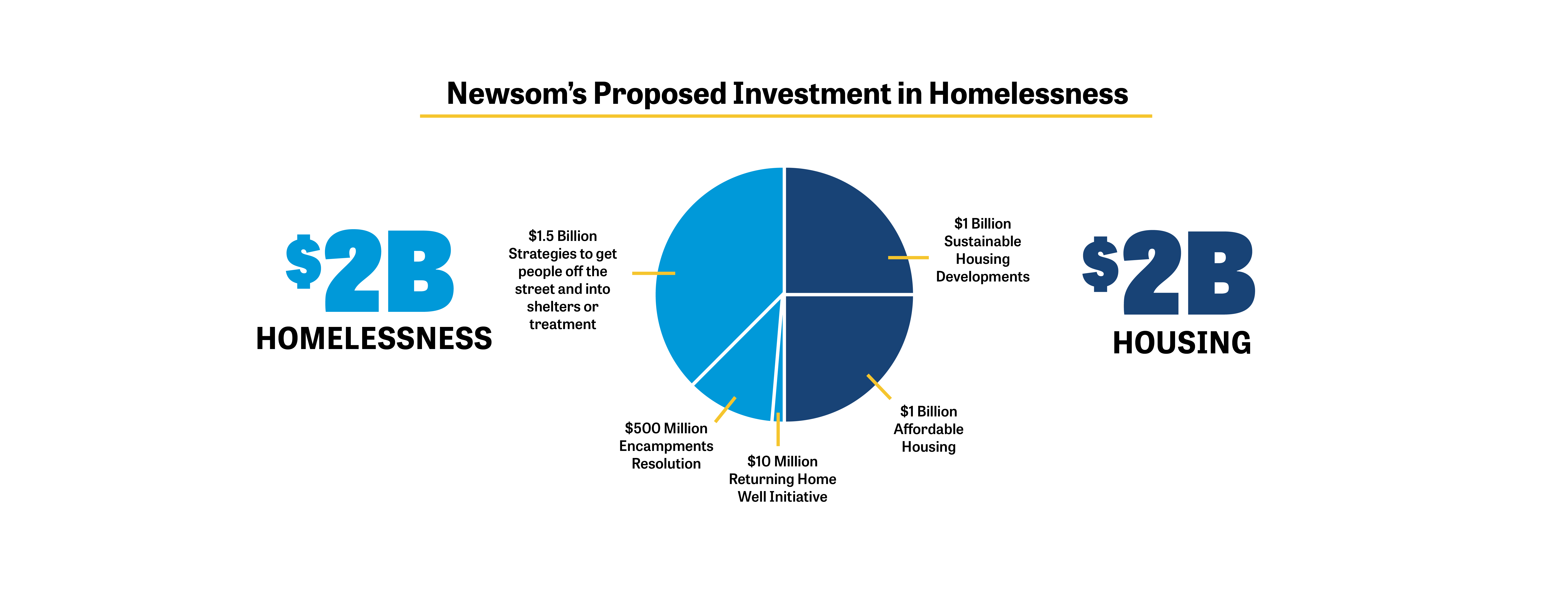Legislative Update: Money Matters—A Look at the Budget Forecast

Zak Franet is a Director at Ground Floor Public Affairs, a San Francisco based government relations and community outreach firm, who has supported the work of the All In Campaign since its launch. He also has lived experience with homelessness, having spent his early adulthood on the streets of Oakland, CA. Zak also serves on the Community Advisory Council for All Home CA, an organization dedicated to ending homelessness and promoting affordable housing throughout the Bay Area.
A surplus of resources, yet widening inequality perseveres
At the All In Campaign we believe in a transparent and inclusive approach to our community’s response to homelessness. Of the utmost importance is transparency in how and why we allocate our resources. Although we’ve covered the budget before, this year’s is especially unique as both the California and City and County of San Francisco are reporting record surpluses—$45B and $108M respectively. California’s surplus is so robust that it has triggered the Gann Limit, a voter-approved bill from the 1970s which places a ceiling on annual appropriations (i.e., government spending). This means over $2B of the surplus might be given back directly to taxpayers.
The dichotomy of the State returning taxpayer dollars while leading the nation in the highest rate of unsheltered homelessness and Supplemental Poverty Rate has not been lost on us. California has a progressive tax policy, which means over half of its general fund revenue comes from high-income earners, including this year’s budget surplus which was only made possible by taxing wealth gains from the top 1% earners. Regardless of the general fund’s growth, these revenue streams highlight that widening income inequality is ever-present in California and detrimentally affects many residents’ ability to stay housed.
Widening inequality is why the State must invest in resources that support those experiencing or susceptible to homelessness generously, quickly, and effectively. While the Mayor has yet to release a detailed budget proposal (more on that in the coming months), we wanted to take the time to offer our take on the State’s budget and what that might mean to our efforts to address homelessness.
Why the Proposed Budgets matter
Whether locally, statewide, or federally, control over the budget is one of the executive branch’s chief mechanisms for implementing its policy agenda. However, the way in which the executive branch allocates the State’s resources can mean the difference between Californians living in a world where homelessness is the status quo, or a distant memory.
This year’s budget blueprint (aka, an overarching plan that lays out how California will allocate its resources annually) was released by Governor Newsom on Monday, January 10th. At a whopping $286.4B, California’s budget dwarfs its peers across the country and has the ability to invest significant dollars to support a myriad of homelessness and housing strategies.
Here’s a high-level overview of the Governor’s proposed investments categorized by issue area:

This year, in direct homelessness funding, a majority of the Governor’s proposed budget is dedicated to encampment resolution and increasing shelter capacity. Of course, that comes on top of the last year’s historic investment in Project Homekey ($2.75Bn)—the Governor’s program meant to rapidly scale and expand Permanent Supportive Housing options. As we have shared, San Francisco has already acquired several new PSH buildings using Project Homekey funds, and there are more potential projects in the pipeline.
What Happens Next?
Now in the hands of the Legislature, the Budget Chairs of the California Assembly (Asm. Phil Ting) and Senate (Sen. Nancy Skinner) will introduce the Governor’s proposed budget to the Legislature. After introducing the proposed budget, the Budget Chairs will send the proposal to a nonpartisan advisory board called the Legislative’s Analyst’s Office (LAO). The LAO then sends a report back to the Legislature and their subcommittees a set of revisions and recommendations, including an analysis of budget allocations for California’s critical issues (e.g., education, health, human services, state administration).
The State Assembly and Senate will then revise the budget based on subcommittees and LAO’s recommendations. Both the Assembly and Senate must approve their own proposals before a conference committee is held to establish a single Legislative version of the budget for the Governor’s approval. The Governor may approve the budget outright but can make further revisions and send it back to the Legislature. However, the Governor must pass a balanced budget no later than July 1st.
Read more about California’s budget process and timeline here
Budget hearings are an excellent time to get in contact with your State Assemblymember and Senator in order to advocate for additional resources spent on individuals experiencing homelessness. The All In Campaign is here to support all forms of advocacy by informing you of opportunities and policies that support strategies that reduce homelessness.

